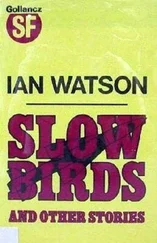Ian Watson - The Embedding
Здесь есть возможность читать онлайн «Ian Watson - The Embedding» весь текст электронной книги совершенно бесплатно (целиком полную версию без сокращений). В некоторых случаях можно слушать аудио, скачать через торрент в формате fb2 и присутствует краткое содержание. Жанр: Фантастика и фэнтези, на английском языке. Описание произведения, (предисловие) а так же отзывы посетителей доступны на портале библиотеки ЛибКат.
- Название:The Embedding
- Автор:
- Жанр:
- Год:неизвестен
- ISBN:нет данных
- Рейтинг книги:4 / 5. Голосов: 1
-
Избранное:Добавить в избранное
- Отзывы:
-
Ваша оценка:
- 80
- 1
- 2
- 3
- 4
- 5
The Embedding: краткое содержание, описание и аннотация
Предлагаем к чтению аннотацию, описание, краткое содержание или предисловие (зависит от того, что написал сам автор книги «The Embedding»). Если вы не нашли необходимую информацию о книге — напишите в комментариях, мы постараемся отыскать её.
The Embedding — читать онлайн бесплатно полную книгу (весь текст) целиком
Ниже представлен текст книги, разбитый по страницам. Система сохранения места последней прочитанной страницы, позволяет с удобством читать онлайн бесплатно книгу «The Embedding», без необходимости каждый раз заново искать на чём Вы остановились. Поставьте закладку, и сможете в любой момент перейти на страницу, на которой закончили чтение.
Интервал:
Закладка:
“How do I know what Bruxo said? Maka-i was in him, not in us.”
“Why was that? Isn’t there much of the maka-i left?”
“She needs a lot. Maybe Bruxo keeps it for her.”
“She? But you said women don’t take maka-i!”
Kayapi nodded.
“But she’s pregnant, Kayapi!”
“You speak like a baby who has found the sun is in the sky!”
“Sorry, Kayapi. I’m a stupid Caraiba. Not a Xemahoa like you. I have to learn.”
“Then I tell you a story, Pee-áir. You listen and learn.”
So I listened, and recorded Kayapi’s story.
“I tell you about Soul Laughter and Stupid Gaiety. Okay? Now, many creatures want to make men laugh with Stupid Gaiety so that they can get inside us, past our tongue, when it is not the master of words. The monkeys play tricks up in the trees to get us to laugh. But we do not laugh. Except for a scornful burst of Soul Laughter which sends them running away.
“Do you know how Man is made, Pee-áir? He is made of a hollow log and a hollow stone joined together. Some say a round gourd but I think a hollow stone. Now the hollow log is lying on the soil one day when along come two snakes. One is a man snake. The other is a woman snake. The woman snake wants to live inside the log, but she can see no way into it. The ends are closed up. There are no branch holes in it. She is unhappy. She asks the man snake how she can get inside. He thinks he knows the way. He runs away and brings his friend the woodpecker, asks him to tap with his beak at the log to try to make a hole. But the wood is so hard, it hurts the woodpecker’s mouth. The woman snake is still unhappy. So again the man snake runs away and brings another friend. A small bird named kai-kai. Kai-kai is lighter than a feather and sings a very deep long song, although he is so small. He sings the way the Bruxo chants, round and round, deep and deep. The snake likes kai-kai because when kai-kai sings, the snake understands how to curl round and round himself. You are listening to me, Pee-áir? I am telling you.”
“I’m listening Kayapi. My box is listening. I don’t understand everything yet—but I will.”
But Kayapi got bored with my not understanding and put the rest of the story off to another day.
A note on the Xemahoa language.
The form of the future tense is peculiar. I’m still not sure it is a true future tense. More like an emphatic present containing the seeds of futurity—a ‘mood’ peculiar to Xemahoa. They add the word ‘yi’, meaning literally ’now’, on to the present verb, or else ‘yi-yi’, ‘now-now’. Kayapi explained the difference to me by saying the present tense of the verb ‘to eat’ while holding his hand to his mouth and moving his lips. Then he held his hand further away from his mouth and pursed his lips and said the eat-verb with ‘yi’ added on. Finally he thrust his hand as far away as it would go and made a tight face like a man sucking a lemon and said the eat-verb followed by ‘yi-yi’. I interpret these three versions of the verb as ‘now’, ‘the immediate future’, and ‘the far future’—but they are all treated as aspects of the present tense by the Xemahoa.
Odd that the weight of ‘now’ upon the present should distance the present into the future. Yet I begin to suspect that this is an essential feature of this remarkable language. If Xemahoa B—the drug speech—is as deeply self-embedded as my recordings lead me to suspect, then an utterance ‘now’ is already pregnant with the future completion of the utterance. It aims to abolish the spread-out through time of a statement—which inevitably occurs since it takes time to utter a statement (by which time conditions have changed and the statement may no longer be quite so true).
Another note on the Xemahoa language.
In fact the measuring of time is more subtle than I thought. They are able to use the same bird-feather words that count numbers to measure time past and time future. However, the ‘numbers’ of time are not fixed units. Instead they apparently modulate according to the context of reference. The same numbers can thus measure and quantify the stages in the development of the human foetus from conception through to birth, as in another context can measure and quantify the stages of a man’s whole life.
Confusing enough for a poor Caraiba like me! Yet it’s an admirably sophisticated and flexible—if highly culture-specific—instrument. The qualifiers ‘yi’ and ‘yi-yi’ play an important part in this. Thus the compound word ‘kai-kai-yi’ signifies ‘x’ quanta of whatever it is (of stages of pregnancy, of the ages of Man, of sections of a ritual) forward along the time-line; while, equally useful and ingenious, the term ‘yi-kai-kai’ signifies V quanta from the present back along the time-line towards the past—back along that embedding stream of words that bears life along.
Kayapi picked up his story at the point where he dropped it a couple of days ago.
“Are you listening, Pee-áir? Kai-kai sings a funny song. He tries to make the log laugh. Because he knows the woodpecker will never succeed in breaking a hole through the log by means of violence. His song is funny because it goes round-and-round and in-and-in. Because it sings the same shape of song as the shape of the snake when he curls himself round himself.
“Yet even this song does not make the log laugh. The log keeps his mouth shut tight. Then kai-kai has an idea. Remember, he is so light. His claws are not like the woodpecker’s heavy claws. Kai-kai’s claws tickle the log…”
I didn’t recognize the word for ‘tickle’. Kayapi demonstrated by tickling me in the ribs.
He tickled me cleverly—the way kai-kai must have tickled the log, in the story. He was trying to make me laugh. But I remembered about Profane Gaiety and kept a straight face. He smiled approvingly.
“So kai-kai tickles the log, till the log laughs. In the moment the log opens his mouth to laugh, the woman snake jumps in through the log’s mouth. She coils round and round inside, before the log has time to spit her out.
“That, Pee-áir,” he proclaimed, smacking his belly with the flat of his hand, “is how we men come to have entrails. But woman still has a little of the hollow of the log inside her—that’s where her baby finds the space to coil up in…
“I’m hungry, Pee-áir,” he grinned. “My belly has a hole in it…”
He wandered off to get some dried fish—piraracu—which he gnawed on.
It had been raining heavily. Now, for a time, thin rays of light filtered down through the branches, creepers and parasites of the forest upon a wet world.
Away in the forest, the grunt, scuttle, splash of a wild pig, as some of the youth hunted it down cautiously— queixada is more vicious and violent than the jaguar. Finally, echoing across the mirror of water, a piercing squeal of death…
Today Kayapi finished the story.
“That is how entrails came to be, Pee-áir. However the man snake wants somewhere for himself also. He moves on till he comes to this stone.”
“Which some say is a gourd ?”
Kayapi grinned.
“Yes, Pee-áir, but I think it is a hollow stone. It keeps its mouth tight shut. It has seen what happened to the log. So the man snake wonders. Then he goes away and asks his friend the woodpecker to bite a hole in the stone. But this hurts the woodpecker’s mouth more than the log hurt him. He goes right away. So the snake asks his friend kai-kai to tickle the stone, but the stone cannot feel what the log could feel. Kai-kai is too small and light. So the man snake goes and asks his friend the pigeon (‘a-pai-i’) to come and help him. A-pai-i treads on the stone, to tickle it, but the stone holds its mouth shut tight. So the man snake thinks again. He moves in front of the stone where the stone can see him. And there he ties himself in a knot.”
Читать дальшеИнтервал:
Закладка:
Похожие книги на «The Embedding»
Представляем Вашему вниманию похожие книги на «The Embedding» списком для выбора. Мы отобрали схожую по названию и смыслу литературу в надежде предоставить читателям больше вариантов отыскать новые, интересные, ещё непрочитанные произведения.
Обсуждение, отзывы о книге «The Embedding» и просто собственные мнения читателей. Оставьте ваши комментарии, напишите, что Вы думаете о произведении, его смысле или главных героях. Укажите что конкретно понравилось, а что нет, и почему Вы так считаете.












